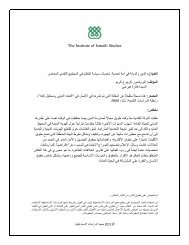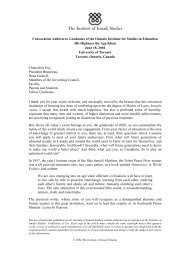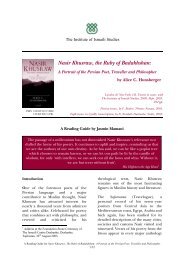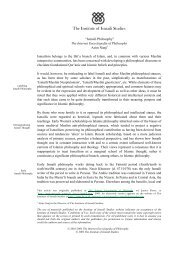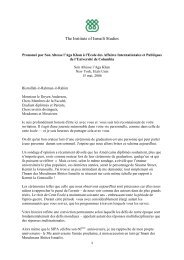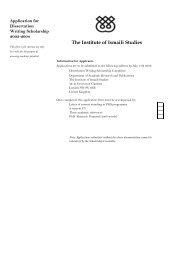The Institute of Ismaili Studies 1
The Institute of Ismaili Studies 1
The Institute of Ismaili Studies 1
You also want an ePaper? Increase the reach of your titles
YUMPU automatically turns print PDFs into web optimized ePapers that Google loves.
social classes. This may explain why he substituted Persian for Arabic as the religious language <strong>of</strong> the<br />
<strong>Ismaili</strong>s <strong>of</strong> Persia (see Daftary, “Hasan-i Sabbah and the Origins <strong>of</strong> the Nizari <strong>Ismaili</strong> Movement,” in<br />
Daftary, ed., 1996, pp. 181-204). It was under such circumstances that, in al-Mustansir’s succession<br />
dispute, Hasan supported Nizar’s cause and severed his relations with the Fatimid regime and the<br />
da‘wa headquarters in Cairo which had supported al-Musta‘li. By this decision, Hasan had founded<br />
the independent Nizari <strong>Ismaili</strong> da‘wa on behalf <strong>of</strong> the Nizari imam. As a result <strong>of</strong> this decision, the<br />
Nizari da‘wa survived the downfall <strong>of</strong> the Fatimid dynasty, a pattern similar to the subsequent fate <strong>of</strong><br />
the Tayyibi da‘wa in Yemen (Juvayni, III, pp. 186-216; tr. Boyle, II, pp. 666-83; Rashid al-Din, pp.<br />
97-137; Kashani, pp. 133-72; Hodgson, 1955, pp. 41-98; Daftary, 1990, pp. 324-71).<br />
<strong>The</strong> revolt <strong>of</strong> the Persian <strong>Ismaili</strong>s soon acquired a distinctive pattern and method <strong>of</strong> struggle, adapted<br />
to the decentralised power structure <strong>of</strong> the Saljuq sultanate and their much superior military power.<br />
Hasan devised a strategy to overwhelm the Saljuqs locality by locality and from a multitude <strong>of</strong><br />
impregnable mountain strongholds. Hasan Sabbah did not divulge the name <strong>of</strong> Nizar’s successor to<br />
the imamate. In fact, numismatic evidence shows that Nizar’s own name appeared on coins minted at<br />
Alamut for about seventy years after his death in 488 AH/1095 CE, while his progeny were blessed<br />
anonymously (Miles, pp. 155-62). <strong>The</strong> early Nizari <strong>Ismaili</strong>s were thus left without an accessible imam<br />
in another dawr al-satr; and, as in the pre-Fatimid period <strong>of</strong> concealment, the absent imam was<br />
represented in the community by a hujja, his chief representative. Hasan and his next two successors<br />
at Alamut as heads <strong>of</strong> the Nizari da‘wa and state, were recognised as such hujjas (Haft bab-e Baba<br />
Sayyidna, pp. 21-22; Abu Ishaq Quhistani, text p. 23). It seems that already in Hasan Sabbah’s time<br />
many Nizaris believed that a son or grandson <strong>of</strong> Nizar had been secretly brought from Egypt to Persia,<br />
and he became the progenitor <strong>of</strong> the line <strong>of</strong> the Nizari imams who later emerged at Alamut (Juvayni,<br />
III, pp. 180-81,231-37; tr. Boyle, II, pp. 663, 691-95; Rashid al-Din, pp. 79, 166-68; Kashani, pp.115,<br />
202-4).<br />
From early on in the Alamut period, the outsiders had the impression that the Persian <strong>Ismaili</strong>s had<br />
initiated a “new preaching” (al-da‘wa al-jadida) in contrast to the “old preaching” (al-da‘wa alqadima)<br />
<strong>of</strong> the Fatimid times. <strong>The</strong> “new preaching” did not, however, represent any new doctrines; it<br />
was merely a reformulation <strong>of</strong> the old Shi‘i doctrine <strong>of</strong> ta‘lim, or authoritative teaching by the imam.<br />
It was mainly Hasan Sabbah himself who restated this doctrine in a theological treatise entitled al-<br />
Fusul al-arba‘a, or <strong>The</strong> Four Chapters. This treatise, originally written in Persian, has been preserved<br />
only in parts (see Shahrastani, pp. 150-52; tr. Gimaret and Monnot, I, pp. 560-65; Juvayni, III, pp.<br />
195-99; tr. Boyle, II, pp. 671-73; Rashidal-Din, pp. 105-7; Kashani, pp. 142-43; Hodgson, 1955, pp.<br />
51-61, 325-28). <strong>The</strong> doctrine <strong>of</strong> ta‘lim, emphasising the autonomous teaching authority <strong>of</strong> each imam<br />
in his own time, became the central doctrine <strong>of</strong> the Nizaris who, henceforth, were designated also as<br />
the Ta‘limiya. <strong>The</strong> intellectual challenge posed to the Sunni establishment by the doctrine <strong>of</strong> ta‘lim,<br />
which also refuted the legitimacy <strong>of</strong> the ‘Abbasid caliph as the spiritual spokesman <strong>of</strong> all Muslims,<br />
called forth the reaction <strong>of</strong> the Sunnis. Many Sunni scholars, led by Ghazali, attacked the <strong>Ismaili</strong><br />
doctrine <strong>of</strong> ta‘lim (see Ghazali, Faza’ih al-Batiniya, ed. ‘A. Badawi, Cairo, 1964; Mitha, pp. 28-102).<br />
By 489 AH/1096 CE, when the fortress <strong>of</strong> Lamasar was seized, Hasan had acquired or built numerous<br />
mountain strongholds in Rudbar, the centre <strong>of</strong> Nizari power. At the same time, the <strong>Ismaili</strong>s had come<br />
to possess a network <strong>of</strong> fortresses and several towns in Quhistan, in southeastern Khurasan, which<br />
remained the second most important territory <strong>of</strong> the Nizari state. Later, the Nizaris acquired Girdkuh<br />
and other fortresses in the regions <strong>of</strong> Qumes, Arrajan and Zagros. By the opening years <strong>of</strong> the<br />
6th/12th century, Hasan had begun to extend his activities into Syria by sending Persian da‘is from<br />
Alamut. By the final years <strong>of</strong> Hasan’s life, the anti-Saljuq revolt <strong>of</strong> the Persian Nizaris had lost its<br />
…Please see copyright restrictions on page 1<br />
14



